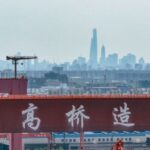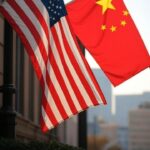Energy News Beat
China’s grip on global shipbuilding is growing ever stronger, building a sizeable gap from second place, South Korea, with some warning the dominance the People’s Republic exerts in this construction sector could become an early target from the incoming Donald Trump administration in the US.
At the start of the century, China accounted for less than 10% of global ship completions. Within 10 years, however, it had surpassed both Japan and South Korea to become the world’s top shipbuilding nation. Over the past 18 months it has noticeably stretched its lead at the top with many yards announcing plans to increase their capacity, while some mothballed shipyards have been reopened, notably Rongsheng, which by itself adds a full percent in terms of global shipbuilding capacity.
Data from Xclusiv Shipbrokers shows that Chinese shipyards experienced a 17% year-on-year surge in new orders across the four main sectors – bulk carriers, tankers, gas, and containers – in the first 10 months of this year. This increased their market share to 74%, up from 63% in 2023’s orders.
Chinese shipyards dominate the container and bulk carrier sectors in 2024, securing 90% of total container orders and 81% of total bulk carrier orders, according to data from the Greek broker. The tanker sector follows with 72% of orders placed in Chinese shipyards. In the gas sector, China maintains a significant 44% share.
Data from Danish Ship Finance shows that China now controls 42% – or 24m cgt – of the global yard capacity, distributed between 140 yards, and has secured 57% of vessel capacity currently on order with South Korea clearly losing ground to China.
Investors in Chinese orderbooks will be wary of falling foul of Trump’s hardline approach
“China’s dominance in shipbuilding is set to continue,” states a recent report from Xclusiv. In 2026, for instance, 70% of bulk carrier vessels added to the fleet will be built in China. China’s market share in the tanker sector is also projected to increase to 67%
China’s stranglehold in the ship construction sector is expected to be discussed early on when the new Trump cabinet assembles in Washington DC in the new year.
South Korean shipyard stock rallied last week following Trump’s stated wish to strengthen relationships with South Korean shipyards. For several months, US shipbuilding unions have been pushing for punitive action to be taken against Chinese shipbuilders that they accuse of receiving unfair support from the Chinese state.
“Investors in Chinese orderbooks will be wary of falling foul of Trump’s hardline approach towards Chinese business,” analysts at broker Braemar advised recently.
The US Trade Representative (USTR) launched an investigation into China’s shipbuilding practices this April, with the outgoing Biden administration reacting to unions and bipartisan calls to clamp down on pricing policies for newbuilds constructed in the People’s Republic.
A Chinese Commerce Ministry spokesperson dismissed the shipbuilding probe when it was announced, telling reporters in Beijing: “It lacks factual basis and goes against economic common sense to blame China for America’s own industrial problems.”
Canada has also joined a growing chorus of shipyard nations taking aim at China.
Colin Cooke, president and CEO, Canadian Marine Industries and Shipbuilding Association (CMISA), delivered a hard-hitting message to Ottawa earlier this year demanding that the Justin Trudeau administration enact tariffs against Chinese-built ships, following on from similar calls in the US and Europe.
Canada recently imposed a 100% surtax on Chinese-made electric vehicles, something CMISA would like to see extended to Chinese-built ships, which Cooke claimed in a release presents an even greater “strategic and ethical threat”.
“China’s shipbuilding industry operates under the doctrine of Civil-Military Fusion whereby commercial ship exports are subsidized to strengthen the country’s military capabilities,” Cooke maintained.
CMISA is calling for the imposition of a 100% surtax on all Chinese-built ships imported into Canada and demand a clear prohibition on any government entity from acquiring or leasing Chinese-built vessels.
“It is imperative that the government takes these steps to protect Canadian industries, uphold national security, and ensure that our economic policies are consistent with our commitment to human rights and ethical business practices,” Cooke wrote.
European shipbuilders have also held a rallying call, determined to claw back business, urging politicians to come onboard.
SEA Europe, the association representing the European maritime technology industry, comprising shipyards and maritime equipment manufacturers, met with European members of parliament earlier this year in a call to action to European policymakers to formulate a comprehensive European maritime industrial strategy.
“Because of substantial price differentials of 30% to 40%, combined with advantageous financial incentives – especially offered by Chinese banks – European shipowners have increasingly opted for Asian shipbuilders,” a release from SEA Europe stated.
Writing on LinkedIn recently, Vincent Guerre, director for trade and competitiveness at SEA Europe, argued: “While access to cheaper vessels benefits shipowners, it also introduces the risk of excessive dependence. The consequences often remain unseen until a crisis occurs, which is becoming increasingly likely amid current geopolitical tensions.”
In related news, in July this year, the US, Canada and Finland agreed to work together to build more polar icebreakers.
The so-called ICE Pact – which stands for Icebreaker Collaboration Effort – is a potential sizeable bonus for many shipyards in North America and Scandinavia.
“The ICE Pact will reinforce the message to Russia and China that the United States and its allies intend to … doggedly pursue collaboration on industrial policy to increase our competitive edge in strategic industries like shipbuilding, to build a world-class polar icebreaking fleet at scale,” a senior US official told reporters at the time of the launch of the pact.
Shipyard politics were discussed at length at last month’s Maritime CEO Forum held at the Monaco Yacht Club.
“I think we’re going to get more and more regulation, more and more tariffs, more and more anti-trade positions and probably more and more national fleets carrying their own cargo, protected by their own navies,” said Graham Porter, chairman of Tiger Group Investments.

The post China stretches lead at the top of shipbuilding stakes appeared first on Energy News Beat.









